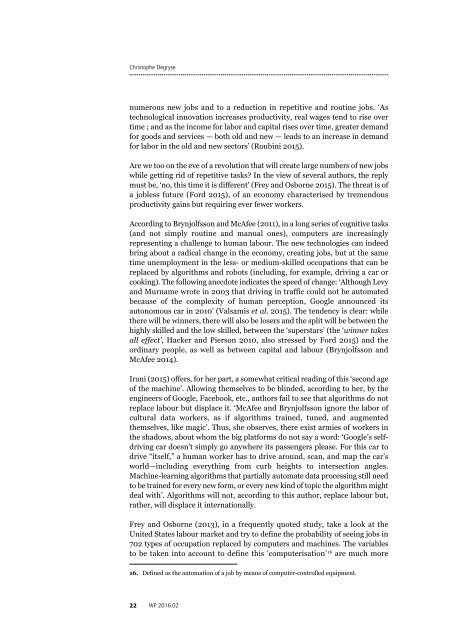Digitalisation of the economy and its impact on labour markets —
ver+2+web+version+Working+Paper+2016+02-EN+digitalisation
ver+2+web+version+Working+Paper+2016+02-EN+digitalisation
Create successful ePaper yourself
Turn your PDF publications into a flip-book with our unique Google optimized e-Paper software.
Christophe Degryse<br />
numerous new jobs <str<strong>on</strong>g>and</str<strong>on</strong>g> to a reducti<strong>on</strong> in repetitive <str<strong>on</strong>g>and</str<strong>on</strong>g> routine jobs. ‘As<br />
technological innovati<strong>on</strong> increases productivity, real wages tend to rise over<br />
time ; <str<strong>on</strong>g>and</str<strong>on</strong>g> as <str<strong>on</strong>g>the</str<strong>on</strong>g> income for labor <str<strong>on</strong>g>and</str<strong>on</strong>g> capital rises over time, greater dem<str<strong>on</strong>g>and</str<strong>on</strong>g><br />
for goods <str<strong>on</strong>g>and</str<strong>on</strong>g> services <strong>—</strong> both old <str<strong>on</strong>g>and</str<strong>on</strong>g> new <strong>—</strong> leads to an increase in dem<str<strong>on</strong>g>and</str<strong>on</strong>g><br />
for labor in <str<strong>on</strong>g>the</str<strong>on</strong>g> old <str<strong>on</strong>g>and</str<strong>on</strong>g> new sectors’ (Roubini 2015).<br />
Are we too <strong>on</strong> <str<strong>on</strong>g>the</str<strong>on</strong>g> eve <str<strong>on</strong>g>of</str<strong>on</strong>g> a revoluti<strong>on</strong> that will create large numbers <str<strong>on</strong>g>of</str<strong>on</strong>g> new jobs<br />
while getting rid <str<strong>on</strong>g>of</str<strong>on</strong>g> repetitive tasks? In <str<strong>on</strong>g>the</str<strong>on</strong>g> view <str<strong>on</strong>g>of</str<strong>on</strong>g> several authors, <str<strong>on</strong>g>the</str<strong>on</strong>g> reply<br />
must be, ‘no, this time it is different’ (Frey <str<strong>on</strong>g>and</str<strong>on</strong>g> Osborne 2015). The threat is <str<strong>on</strong>g>of</str<strong>on</strong>g><br />
a jobless future (Ford 2015), <str<strong>on</strong>g>of</str<strong>on</strong>g> an <str<strong>on</strong>g>ec<strong>on</strong>omy</str<strong>on</strong>g> characterised by tremendous<br />
productivity gains but requiring ever fewer workers.<br />
According to Brynjolfss<strong>on</strong> <str<strong>on</strong>g>and</str<strong>on</strong>g> McAfee (2011), in a l<strong>on</strong>g series <str<strong>on</strong>g>of</str<strong>on</strong>g> cognitive tasks<br />
(<str<strong>on</strong>g>and</str<strong>on</strong>g> not simply routine <str<strong>on</strong>g>and</str<strong>on</strong>g> manual <strong>on</strong>es), computers are increasingly<br />
representing a challenge to human <strong>labour</strong>. The new technologies can indeed<br />
bring about a radical change in <str<strong>on</strong>g>the</str<strong>on</strong>g> <str<strong>on</strong>g>ec<strong>on</strong>omy</str<strong>on</strong>g>, creating jobs, but at <str<strong>on</strong>g>the</str<strong>on</strong>g> same<br />
time unemployment in <str<strong>on</strong>g>the</str<strong>on</strong>g> less- or medium-skilled occupati<strong>on</strong>s that can be<br />
replaced by algorithms <str<strong>on</strong>g>and</str<strong>on</strong>g> robots (including, for example, driving a car or<br />
cooking). The following anecdote indicates <str<strong>on</strong>g>the</str<strong>on</strong>g> speed <str<strong>on</strong>g>of</str<strong>on</strong>g> change: ‘Although Levy<br />
<str<strong>on</strong>g>and</str<strong>on</strong>g> Murname wrote in 2003 that driving in traffic could not be automated<br />
because <str<strong>on</strong>g>of</str<strong>on</strong>g> <str<strong>on</strong>g>the</str<strong>on</strong>g> complexity <str<strong>on</strong>g>of</str<strong>on</strong>g> human percepti<strong>on</strong>, Google announced <str<strong>on</strong>g>its</str<strong>on</strong>g><br />
aut<strong>on</strong>omous car in 2010’ (Valsamis et al. 2015). The tendency is clear: while<br />
<str<strong>on</strong>g>the</str<strong>on</strong>g>re will be winners, <str<strong>on</strong>g>the</str<strong>on</strong>g>re will also be losers <str<strong>on</strong>g>and</str<strong>on</strong>g> <str<strong>on</strong>g>the</str<strong>on</strong>g> split will be between <str<strong>on</strong>g>the</str<strong>on</strong>g><br />
highly skilled <str<strong>on</strong>g>and</str<strong>on</strong>g> <str<strong>on</strong>g>the</str<strong>on</strong>g> low skilled, between <str<strong>on</strong>g>the</str<strong>on</strong>g> ‘superstars’ (<str<strong>on</strong>g>the</str<strong>on</strong>g> ‘winner takes<br />
all effect’, Hacker <str<strong>on</strong>g>and</str<strong>on</strong>g> Piers<strong>on</strong> 2010, also stressed by Ford 2015) <str<strong>on</strong>g>and</str<strong>on</strong>g> <str<strong>on</strong>g>the</str<strong>on</strong>g><br />
ordinary people, as well as between capital <str<strong>on</strong>g>and</str<strong>on</strong>g> <strong>labour</strong> (Brynjolfss<strong>on</strong> <str<strong>on</strong>g>and</str<strong>on</strong>g><br />
McAfee 2014).<br />
Irani (2015) <str<strong>on</strong>g>of</str<strong>on</strong>g>fers, for her part, a somewhat critical reading <str<strong>on</strong>g>of</str<strong>on</strong>g> this ‘sec<strong>on</strong>d age<br />
<str<strong>on</strong>g>of</str<strong>on</strong>g> <str<strong>on</strong>g>the</str<strong>on</strong>g> machine’. Allowing <str<strong>on</strong>g>the</str<strong>on</strong>g>mselves to be blinded, according to her, by <str<strong>on</strong>g>the</str<strong>on</strong>g><br />
engineers <str<strong>on</strong>g>of</str<strong>on</strong>g> Google, Facebook, etc., authors fail to see that algorithms do not<br />
replace <strong>labour</strong> but displace it. ‘McAfee <str<strong>on</strong>g>and</str<strong>on</strong>g> Brynjolfss<strong>on</strong> ignore <str<strong>on</strong>g>the</str<strong>on</strong>g> labor <str<strong>on</strong>g>of</str<strong>on</strong>g><br />
cultural data workers, as if algorithms trained, tuned, <str<strong>on</strong>g>and</str<strong>on</strong>g> augmented<br />
<str<strong>on</strong>g>the</str<strong>on</strong>g>mselves, like magic’. Thus, she observes, <str<strong>on</strong>g>the</str<strong>on</strong>g>re exist armies <str<strong>on</strong>g>of</str<strong>on</strong>g> workers in<br />
<str<strong>on</strong>g>the</str<strong>on</strong>g> shadows, about whom <str<strong>on</strong>g>the</str<strong>on</strong>g> big platforms do not say a word: ‘Google’s selfdriving<br />
car doesn’t simply go anywhere <str<strong>on</strong>g>its</str<strong>on</strong>g> passengers please. For this car to<br />
drive “<str<strong>on</strong>g>its</str<strong>on</strong>g>elf,” a human worker has to drive around, scan, <str<strong>on</strong>g>and</str<strong>on</strong>g> map <str<strong>on</strong>g>the</str<strong>on</strong>g> car’s<br />
world<strong>—</strong>including everything from curb heights to intersecti<strong>on</strong> angles.<br />
Machine-learning algorithms that partially automate data processing still need<br />
to be trained for every new form, or every new kind <str<strong>on</strong>g>of</str<strong>on</strong>g> topic <str<strong>on</strong>g>the</str<strong>on</strong>g> algorithm might<br />
deal with’. Algorithms will not, according to this author, replace <strong>labour</strong> but,<br />
ra<str<strong>on</strong>g>the</str<strong>on</strong>g>r, will displace it internati<strong>on</strong>ally.<br />
Frey <str<strong>on</strong>g>and</str<strong>on</strong>g> Osborne (2013), in a frequently quoted study, take a look at <str<strong>on</strong>g>the</str<strong>on</strong>g><br />
United States <strong>labour</strong> market <str<strong>on</strong>g>and</str<strong>on</strong>g> try to define <str<strong>on</strong>g>the</str<strong>on</strong>g> probability <str<strong>on</strong>g>of</str<strong>on</strong>g> seeing jobs in<br />
702 types <str<strong>on</strong>g>of</str<strong>on</strong>g> occupati<strong>on</strong> replaced by computers <str<strong>on</strong>g>and</str<strong>on</strong>g> machines. The variables<br />
to be taken into account to define this ‘computerisati<strong>on</strong>’ 16 are much more<br />
16. Defined as <str<strong>on</strong>g>the</str<strong>on</strong>g> automati<strong>on</strong> <str<strong>on</strong>g>of</str<strong>on</strong>g> a job by means <str<strong>on</strong>g>of</str<strong>on</strong>g> computer-c<strong>on</strong>trolled equipment.<br />
22 WP 2016.02


